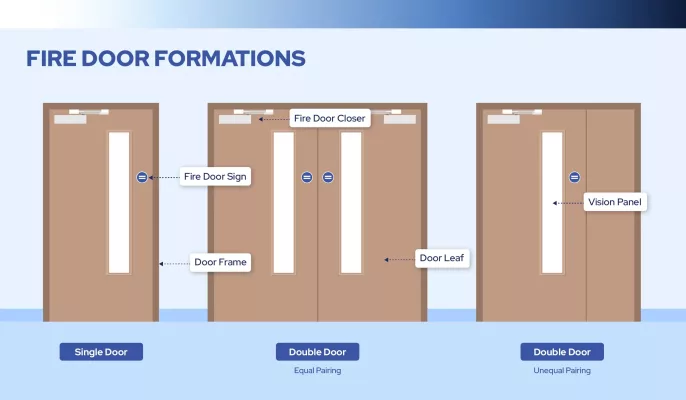When it comes to home and building safety, both burglar-proof doors and fire doors are essential, but they serve different purposes. As a leading fire door manufacturer in China, we aim to help you understand the distinction between these two types of doors, ensuring that you make informed decisions for your security and safety needs. […]
Tag Archives: Differences Between Burglar-Proof Doors and Fire Doors
Differences Between Burglar-Proof Doors and Fire Doors
Introduction
Modern buildings demand doors that do more than open and close. Safety, security, and compliance with international standards have made burglar-proof doors and fire doors essential in residential, commercial, and industrial projects. While both enhance protection, their functions, materials, and testing standards differ significantly. Understanding these differences helps real estate developers, contractors, and distributors make informed procurement decisions.
As a leading Asian fire door and security door manufacturer, YK Door Industry Co., Ltd. provides both burglar-proof and fire-rated solutions, tailored to diverse markets such as Southeast Asia, the Middle East, and Europe.
Core Functionality: Security vs. Fire Protection
Burglar-Proof Doors: Designed to resist forced entry, burglary tools, and in some cases even ballistic threats. Their core mission is to protect property and occupants from external threats.
Fire Doors: Built to contain fire and smoke, allowing occupants to evacuate safely and limiting structural damage. Their function is passive fire protection, not physical security.
Example: YK supplied burglar-resistant steel doors to a luxury villa project in Dubai, where the main concern was theft prevention. In contrast, a hospital project in Nairobi required 90-minute fire doors, prioritizing evacuation safety over intrusion resistance.
Materials and Structural Differences
Burglar-Proof Doors: Often use thicker steel plates, reinforced cores, and multi-point locking systems. The emphasis is on strength against prying, drilling, or impact.
Fire Doors: Typically use steel or wood filled with fire-resistant cores such as mineral wool or vermiculite boards. Their design focuses on heat insulation and smoke control rather than resisting burglary tools.
YK Practice: For a government office in Manila, YK combined steel fire-rated panels with burglary-resistant locks, delivering a dual-purpose door that met both EN fire testing and local burglary resistance standards.
Testing and Certification Standards
Burglar-Proof Doors:
Tested under EN 1627–1630 (Europe) for resistance classes RC2–RC6.
Focus on simulated attacks using common burglary tools.
Fire Doors:
Tested under EN 1634 (Europe), UL 10C (U.S.), or GB 12955 (China).
Ratings define fire resistance duration (30, 60, 90, 120 minutes).
Case Study: YK produced RC3-rated burglar doors for a banking facility in Kenya and EI60 fire doors for a commercial complex in Guangzhou. Each project required different certification processes, showing how standards guide procurement.
Hardware and Functional Features
Burglar-Proof Doors:
Multi-point locking systems, anti-pry hinges, reinforced bolts.
Heavy frames with advanced locks like biometric or electronic access.
Fire Doors:
Self-closing devices, smoke seals, panic bars for evacuation.
Designed to stay functional in high heat conditions.
Example: In a shopping mall in Jakarta, YK installed fire exit doors with luminous panic hardware. In contrast, for a residential complex in Istanbul, YK supplied burglar-proof apartment doors with electronic access systems.
Market Applications
Residential Projects: Villas and apartments prioritize burglar-proof doors to secure occupants.
Hospitals, Schools, Offices: Fire doors dominate because evacuation and compartmentalization are critical.
Mixed-Use Developments: Require a blend of both types, with fire-rated doors for stairwells and burglar-proof entrances for private areas.
YK Strategy: YK works with real estate developers to recommend application-specific solutions, ensuring compliance and cost-effectiveness.
Cost and Value Considerations
Burglar-Proof Doors: Higher cost due to reinforced materials and advanced locking systems.
Fire Doors: Costs vary depending on fire rating and material, but generally lower than high-security doors.
Dual-Purpose Doors: More expensive but reduce installation space and maintenance in complex projects.
Example: A hotel project in Riyadh chose dual-certified YK doors, reducing procurement complexity by 15% and ensuring compliance with both fire and security codes.
Summary Table – Burglar-Proof vs. Fire Doors
| Feature | Burglar-Proof Doors | Fire Doors | YK Case Example |
|---|---|---|---|
| Primary Function | Prevent forced entry | Resist fire & smoke | Dubai villas (security) vs. Nairobi hospital (fire safety) |
| Material Focus | Thick steel, reinforced core | Steel/wood with fire-resistant infill | Manila dual-purpose government project |
| Standards | EN 1627–1630 (RC classes) | EN 1634, UL 10C, GB 12955 | RC3 banking doors vs. EI60 office doors |
| Hardware | Multi-point locks, pry-proof hinges | Closers, smoke seals, panic bars | Jakarta mall (fire exit) vs. Istanbul apartments (burglar-proof) |
| Cost | Generally higher | Moderate, depends on rating | Riyadh hotel dual certification |
FAQ – Guidance for Industry Partners
Q1 (Distributors): Should I stock both fire doors and burglar-proof doors?
Yes. Clients have different needs: residential buyers focus on burglary prevention, while developers of public buildings prioritize fire safety. Stocking both broadens your market reach.
Q2 (Procurement Managers): Can one door meet both burglary and fire standards?
Yes, but dual-purpose doors require specialized testing and cost more. YK offers custom hybrid models for hotels, embassies, and government facilities.
Q3 (Contractors): What’s the most common mistake in specification?
Mixing up functions. For example, using a burglar-proof door in a hospital stairwell fails fire code. Always align doors with project use.
Q4 (Developers): Do fire doors increase property value?
Absolutely. Certified fire doors reduce liability, meet code, and often lower insurance premiums. Burglar-proof doors, meanwhile, enhance buyer confidence in residential sales.
Q5 (Distributors): How can I explain the difference to end buyers?
Highlight that burglar-proof doors keep threats out, while fire doors allow people to escape safely. Simple messaging resonates with clients.


